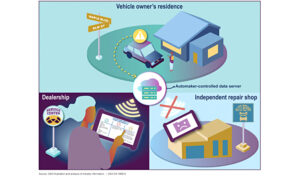Impact of Covid-19 on the new-vehicle market will further extend the initial ownership period, presenting marketing challenges to independent repair outlets
Fort Wayne, Ind.—New cars and light trucks are being kept much longer by their original buyers than ever before, according to a new report by Lang Marketing. Consumers currently keep new vehicles an average of 83 months (nearly 7 years), which is up 50 percent from 2008, when the average buyer drove new a vehicle for only about 4.6 years before replacing it.
“Longer new vehicle ownership will increase the repair and maintenance opportunities of dealers, who can leverage this extended relationship with original buyers into additional bay business. The impact of Covid-19 on the new vehicle market during 2020 and 2021 will further extend the initial ownership period, presenting marketing challenges to independent (non-dealer) repair outlets.”
Below is a summary of the 2021 Lang Aftermarket Annual report and its findings:
Buyers Keep New Vehicles Longer
New car and light truck buyers are keeping their vehicles much longer than they did just a few years ago. As recently as 2008, buyers kept new cars and light trucks just 56 months, on average, before replacing them.
Today, buyers hold on to their new vehicles much longer, for an average of 83 months, or 6.9 years. This is more than two full years longer than the typical ownership cycle of new vehicles in 2008, a 50-percent increase.
Factors Extending New Vehicle Ownership
Three major factors are combining to encourage buyers to keep new cars and light trucks longer.
- First, the prices of new cars and light trucks continue to rise. Higher prices keep many consumers from returning to the new vehicle market as quickly as they did just a few years ago.
- Second, the length of new vehicle loans is climbing ever higher. Last year, the average length of a new vehicle loan covered more than 70 months, with many extending for 84 months and more.
- Third, vehicle manufacturers are delaying major design changes for up to three years, instead of annual styling changes, which were typical in decades past. As a result, consumers can often keep a new vehicle for six or more years without it looking overly dated.
Longer New Vehicle Ownership and Dealer Bays
With new buyers keeping their cars and light trucks longer, dealers have a greater opportunity to establish a repair relationship with owners. As they keep their vehicle longer, many consumers are encouraged to return to the dealer for repairs rather than to an independent outlet.
Evolving Dealer Bay Strategies
Dealer bay activities traditionally have focused on warranty work and repairing the late model nameplates that they sell, especially those under six years old.
However, all that changed with the 2008 Great Recession, when new vehicle sales crashed and dealers were forced to promote service bay business across a wider age and nameplate mix of vehicles in order to survive the loss of showroom business.
Sweet-Spot Repair Opportunity for Dealers
With new car and light truck buyers now keeping their new vehicles an average of 6.9 years, dealers can promote service bay traffic to new vehicle owners over a longer period.
Dealers have the opportunity to continue servicing cars and light trucks into the repair-age sweetspot (6 to 10 years old) for an increasing number of new vehicle buyers.
This helps dealers to attract additional repair business to their bays for vehicle six years and older, business that just a few years ago was shifting away from dealer to independent (non-dealer) service outlets.
2020 and 2021 New Vehicle Sales
The Covid-19 caused new vehicle sales to plunge during 2020, down over 14 percent for the year. And the downturn might not be over. A shortage of component parts, especially computer chips, is threatening to reduce 2021 vehicle production and, thus, sales in the U.S.
This sharply lower new-vehicle volume not only has caused consumers to keep previously purchased vehicles longer, but also has focused the attention of dealers on their service bays as a primary way to generate profits.
Challenge for Independent DIFM Outlets
Independent DIFM outlets must adapt to the increasing length of the new vehicle ownership cycle and the changing repair strategies of dealers, which are aimed at expanding the age and nameplate mix of vehicles that they attract to their service bays.







Comments are closed.